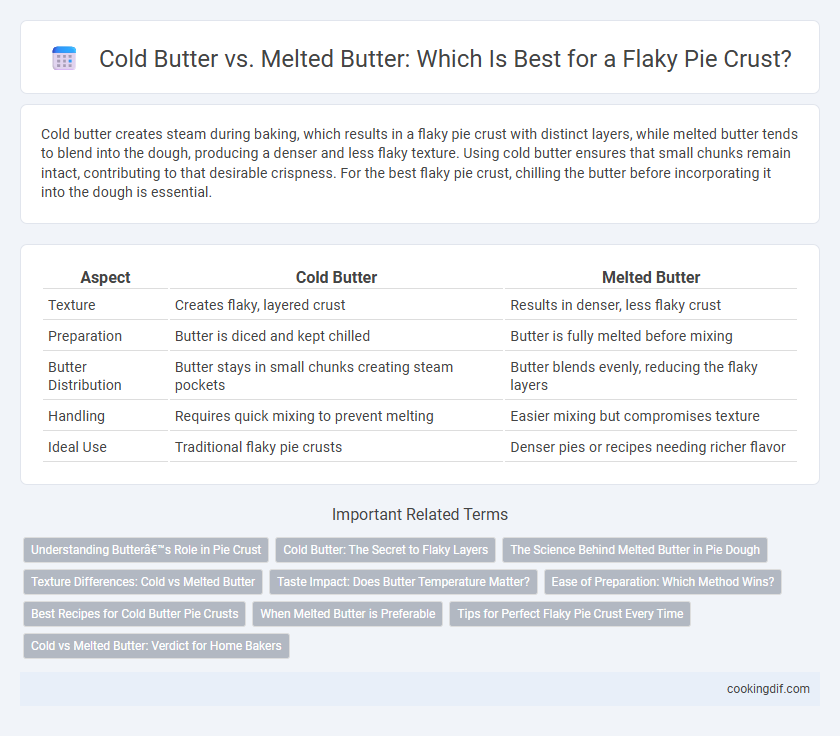Cold butter creates steam during baking, which results in a flaky pie crust with distinct layers, while melted butter tends to blend into the dough, producing a denser and less flaky texture. Using cold butter ensures that small chunks remain intact, contributing to that desirable crispness. For the best flaky pie crust, chilling the butter before incorporating it into the dough is essential.
Table of Comparison
| Aspect | Cold Butter | Melted Butter |
|---|---|---|
| Texture | Creates flaky, layered crust | Results in denser, less flaky crust |
| Preparation | Butter is diced and kept chilled | Butter is fully melted before mixing |
| Butter Distribution | Butter stays in small chunks creating steam pockets | Butter blends evenly, reducing the flaky layers |
| Handling | Requires quick mixing to prevent melting | Easier mixing but compromises texture |
| Ideal Use | Traditional flaky pie crusts | Denser pies or recipes needing richer flavor |
Understanding Butter’s Role in Pie Crust
Cold butter creates steam pockets during baking, resulting in a flaky pie crust texture, while melted butter blends fully into the dough, producing a denser, more uniform crumb. The solid state of cold butter inhibits gluten development by preventing excessive water absorption, which is essential for lightness in pie crusts. Understanding this, bakers prefer cold butter to achieve the signature flaky layers that define classic pastry.
Cold Butter: The Secret to Flaky Layers
Cold butter creates steam pockets during baking, which are essential for flaky pie crust layers. Keeping the butter chilled prevents it from blending fully with the dough, allowing distinct flakes to form. This technique is crucial in achieving the perfect texture and tenderness in classic pie crusts.
The Science Behind Melted Butter in Pie Dough
Melted butter in pie dough coats flour proteins uniformly, reducing gluten formation and resulting in a tender crust. The higher moisture content and fat distribution inhibit extensive gluten development, which keeps the dough more pliable and less chewy. This scientific interaction promotes a delicate texture but sacrifices the distinct flakiness typically achieved with cold butter chunks.
Texture Differences: Cold vs Melted Butter
Cold butter in pie crust creates distinct layers as it melts during baking, resulting in a flaky, tender texture with airy pockets. Melted butter blends fully into the dough, producing a denser, less flaky crust with a more uniform crumb. For optimal flakiness, chilling the dough with solid butter pieces is essential to maintain texture contrast.
Taste Impact: Does Butter Temperature Matter?
Cold butter creates flaky pie crusts by releasing steam during baking, which forms delicate layers, enhancing texture and taste. Melted butter results in denser crusts with a richer, buttery flavor but lacks the characteristic flakiness. The temperature of butter significantly influences the balance between texture and flavor in a pie crust.
Ease of Preparation: Which Method Wins?
Cold butter is preferred for flaky pie crusts as it creates steam pockets during baking, resulting in layers and flakiness, while also allowing easier handling and shaping of dough without becoming greasy or sticky. Melted butter simplifies dough mixing but often leads to a denser crust with less flakiness due to the fat's uniform distribution. For ease of preparation combined with optimal texture, cold butter remains the method of choice among bakers.
Best Recipes for Cold Butter Pie Crusts
Cold butter creates steam during baking, which helps develop flaky layers in pie crusts by preventing the fat from fully melting into the dough. Best recipes for cold butter pie crusts, such as those from James Beard Foundation or King Arthur Baking Company, emphasize cutting butter into small chunks and chilling the dough to maintain distinct butter pockets. This technique ensures a tender, flaky texture compared to melted butter, which produces a denser, less flaky crust.
When Melted Butter is Preferable
Melted butter is preferable for pie crusts when a tender, soft texture is desired, such as in crumbly or cookie-like bases. It integrates more evenly into the dough, promoting thorough hydration and a uniform crumb structure. This method suits no-roll crusts or quick pastry recipes where flakiness is less critical than ease of preparation.
Tips for Perfect Flaky Pie Crust Every Time
Cold butter is essential for creating a flaky pie crust because it releases steam during baking, forming distinct layers. Use butter straight from the refrigerator, cut into small cubes, and work it quickly into the flour without overmixing to maintain these pockets of fat. Avoid melted butter, which blends too thoroughly and results in a dense, less flaky crust.
Cold vs Melted Butter: Verdict for Home Bakers
Cold butter creates a flakier pie crust by maintaining solid fat pieces that release steam during baking, forming distinct layers. Melted butter blends fully into the dough, resulting in a denser, less flaky texture. Home bakers seeking a tender, flaky crust achieve better results using cold butter to preserve the desired pastry structure.
Cold butter vs melted butter for flaky pie crust Infographic

 cookingdif.com
cookingdif.com